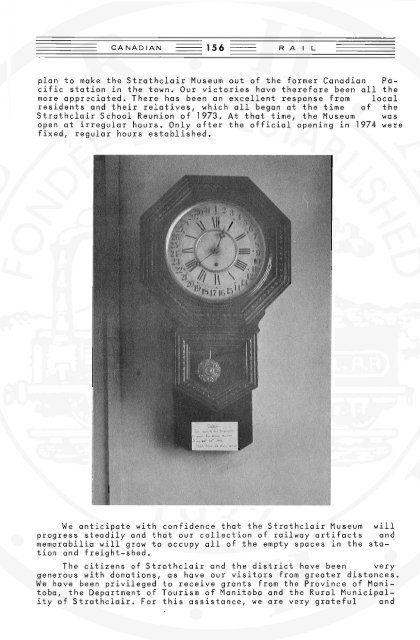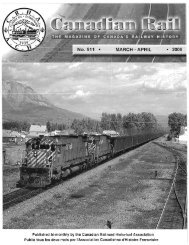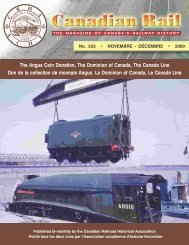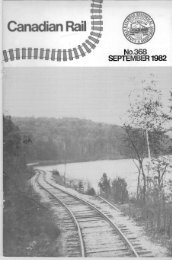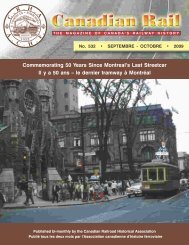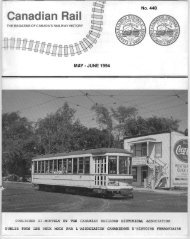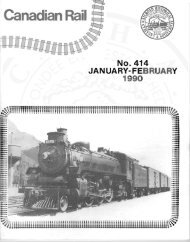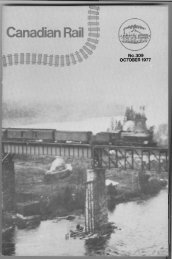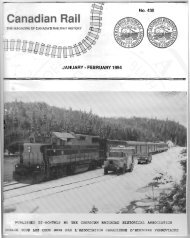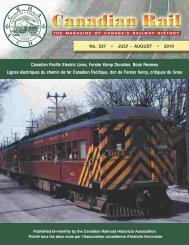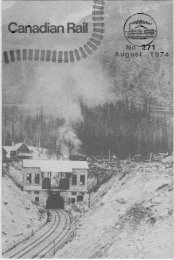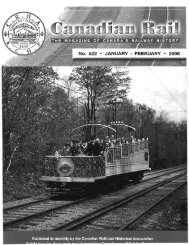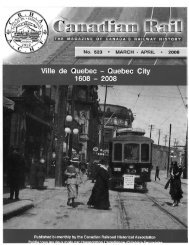Canadian Rail_no292_1976
Canadian Rail_no292_1976
Canadian Rail_no292_1976
You also want an ePaper? Increase the reach of your titles
YUMPU automatically turns print PDFs into web optimized ePapers that Google loves.
(}~MMitte ,<br />
s.s.Worthen<br />
By far the best way to avoid the implementation of<br />
a sound proposal is to refer it to a committee for<br />
further study.<br />
Old political adage.<br />
I ~<br />
N<br />
owadays, hardly anybody pays much attention<br />
to the distance between the rails of any of<br />
Canada's railways. Most people who are even<br />
remotely interested in this characteristic<br />
of the modern railway quit thinking about it<br />
when the Newfoundland <strong>Rail</strong>way became part and<br />
parcel of the <strong>Canadian</strong> National <strong>Rail</strong>way Company<br />
and, subsequently, lost its steam engines.<br />
Granted, there is still the White Pass<br />
and Yukon Route and other lines with slight<br />
differences in track gauge, 'round about the<br />
country, but they are often remote and very<br />
hard to find.<br />
There was a time, back in the early history of our country, when<br />
the distance between the rails was very important. Gauge was quite a<br />
reliable indicator of the future success or failure of the venture •<br />
For nearly 15 years after 1853, the railways in the eastern United<br />
States had to contend with the Grand Trunk <strong>Rail</strong>way Company of Canada,<br />
which was of a non-standard gauge, as far as they were concerned. In<br />
southern Ontario, the Great Western <strong>Rail</strong>way Company busily loaded and<br />
unloaded freight cars at Niagara Falls, Windsor and sarnia, where it<br />
connected with U.S. railroads - all because of the difference in<br />
gauge~<br />
In later years - and farther west - this gauge problem was<br />
encountered, since by the time the western lines were built,<br />
"great contention" about the guage of railways had been settled<br />
a "once-and-for-all" decision rendered.<br />
not<br />
the<br />
and<br />
IN THE INTERVAL 1866-1873, THE STATION OF THE GREAT WESTERN RAILWAY<br />
at Hamilton, Ontario, was a mass of complicated dual-gauge trackwork,<br />
the standard-gauge having been laid alongside the 5-foot,6-inch<br />
"Provincial Gauge" in the former year. When the Provincial Gouge<br />
law was repealed in 1870, the GWR began the conversion to the Stephenson<br />
gauge, to permit easier interchange of traffic with its connections<br />
to the United States at Niagara Falls and Windsor/Detroit.<br />
Photograph courtesy <strong>Canadian</strong> National <strong>Rail</strong>ways.


